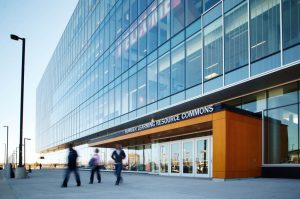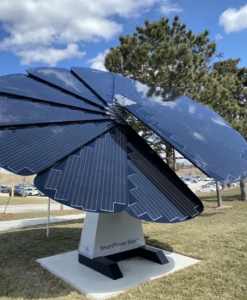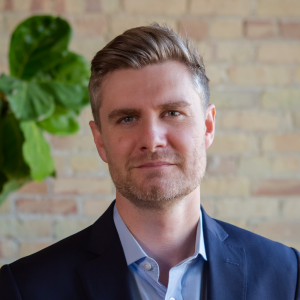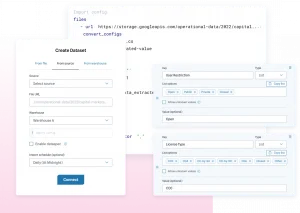Emerging new data management techniques are key to powering up smarter buildings and smarter cities. One of the smartest new techniques involves creating a digital twin, and it’s been used to help reduce energy costs associated with heating cooling and operating a major college campus in the Toronto area.
A digital twin is a virtual replica of a physical object, be it a toaster, a building, a city – perhaps even a person, in the health and medical data sense. The digital twin is a new way to picture, in a digital realm, something that exists in the physical world. Using data collected from a wide range of sources and sensors, along with appropriate tools to make sense of all that data, the virtual replica is used to run simulations of what may happen in the real world. Accurate predictions can be made and concrete actions taken.
Be it in health care, transportation and supply chains, banking and finance, manufacturing, energy management or many other sectors, being able to accurately anticipate how the system will respond to various stimuli is a crucial tool in maintaining peak performance and operating efficiencies.

Humber College is on track to achieve a 30 per cent reduction in greenhouse gas emissions, thanks to smart technology and digital twinning.
At the main campus of Humber College, buildings are being heated and cooled in a smart way, and reports indicate the college’s digital twinning has helped boost energy efficiency by 20 per cent per square foot.
The college reports it is on track to achieve a 30 per cent reduction in greenhouse gas emissions (when compared with rates of ten years ago) compared with a decade ago – even tho’ campus facilities have grown by 25 per cent.
Yes, older buildings have been retrofitted with new insulating windows and energy efficient insulation. But smart sensors have also been installed throughout the school and its operating systems can now share data with each other thanks to their digital twin. Because the separate systems can share data with each other in the virtual replica, facility managers are empowered to operate the lighting, heating and other building systems more efficiently and effectively.

The Smartflower at Humber College has solar panels that open up and follow the sun throughout the day, maximizing the amount of electricity that is generated. Green technology products like Smartflower can be part of a smart micro grid controlled through data analytics.
Buildings can be “pre-cooled” before peak usage and demand periods; room lights are turned on only when people need them, and those times can be accurately anticipated. In cold weather, heat pumps can be triggered to redirect heat from crowded well-used campus environments to other spaces where heat is needed.
The smart systems now used to manage Humber College’s energy consumption are part of a collaboration between Humber and Siemens Canada that’s led to the founding of its SMARTLab, where students put smart technologies and digital twin practices to the test.
(Siemens introduced its virtual accelerator program back in June at the Collision Conference in Toronto. Known as Building X, the digital platform monitors and manages all building systems and communicates with power grids to get the best possible performance. The benefits gleaned so far and still anticipated are among the reasons pushing the value of the digital twins’ predictive abilities is so high: it’s expected the industry will grow from $10 billion today to $110 billion in just five years – a growth rate of some 60 per cent!)
A big player in that growing market is ThinkData Works Inc., a Toronto-based technology company whose platform is used by some of the worlds’ largest organizations to process and refine data into usable products. ThinkData Works’ VP of Product, Lewis Wynne-Jones, is familiar with the Humber College example and very well-versed in business analytics and data management.

ThinkData Works’ VP of Product, Lewis Wynne-Jones
“The success of the SMART lab at Humber College is an example of what’s possible when you manage data effectively within a well-designed ecosystem,” Wynne-Jones said. “But what’s truly innovative is the way the college is collecting the data from all these modern sources and leveraging it to recognize immediate value.”
He describes how, at Humber, the digital twin presents a model representation of the buildings and sensors involved. Unfortunately, one cannot “fly around” the model – not yet! “I’m a pretty visual person, too,” Wynne-Jones laughs, but it’s a misconception to think you can zoom in and fly around these models. Not yet, at any rate! The underpinning architecture is data, he describes.
The twin digests all the data and presents in a more accessible way information about the different systems that might not speak to each other naturally. Some kind of translation engine is needed to manage all the data, all the sources, all the IoT devices that are generating data in a given system. Data lineage is the process of recording, visualizing, and analyzing data as it flows from data sources to consumption.
ThinkData Works has released a new data lineage solution that lets a company better visualize data flows across its entire data ecosystem. The new tool provides needed visibility into data relationships and enables the monitoring of data pipelines for quality control and enhanced governance.
Data lineage provides a lens into where data originates, how it is transformed over time, and where it ends up, giving organizations that use lineage solutions critical information that increases efficiency, ensures trust, and enables innovation.

Automated tools from ThinkData Works are used to clean, combine, and customize ingested data and create project-ready assets.
Wynne-Jones underscores the value of quality control and data governance by noting that within any company’s data ecosystem, a centralized platform must connect to the data wherever it is generated. Data movement – what’s called “lift and shift” – is expensive, he points out, and security is best preserved when not moving or otherwise manipulating it away from “a single source of truth.”
It’s a powerful phrase ThinkData uses to describe the value of digital twins and the auditing of data used to create them.
When it comes to the value of single-sourced, clearly understood data in operating a building or a business, Wynne-Jones says the problem is that as digital information proliferates, it becomes harder to understand. Harder to know its origin. Harder to know if the data is trustworthy.
Data lineage must be clear, practical, and easy-to-interpret. Wynne-Jones talks about the digital audit trail and watermarked data as ways to track what happens to digital information throughout its lifecycle. Data managers and data governance officers need the appropriate tools to work with and environments to work in.
As Wynne-Jones enthusiastically described of his company’s new data tool, “[we] tested our lineage solution against pipelines generating models out of thousands of datasets and within minutes were able to spot dependencies and risks that we’d never seen before. That was when we knew we’d built something incredible.”
Real-time connections to virtualized data does empower better decision-making. It’s a predictive rather than reactive process, and for data users of all sorts, not just the HVAC operators at Humber College, that’s a nice warm place to be.
-30-



